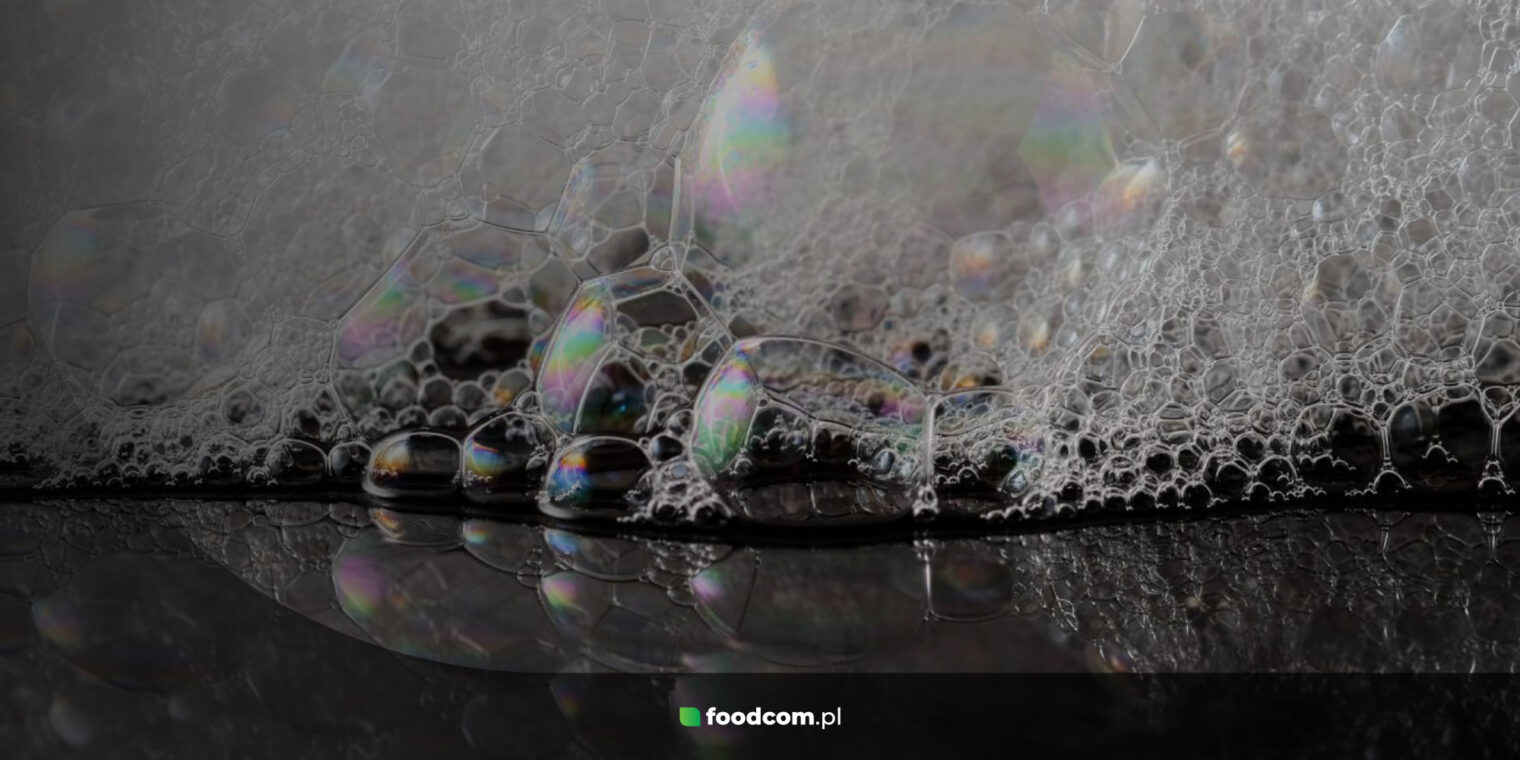- Surfactants are used in many different industries: cosmetics, food, metallurgy, pharmaceuticals, paint and varnish production, and many other applications
- They are divided into four main groups: nonionic, anionic, cationic, and amphoteric surfactants, each with different properties.
- The main applications of surfactants include: emulsifying agents, dispersants, solubilizers, detergents, softeners, cleaning agents, washing agents, and bactericides.
Surfactants (SPC or SAA – Surface Active Agents) are commonly found in our environment, primarily as components of cleaning agents and cosmetics. What characterizes this group of chemical compounds? What is their classification, and how can we apply different types of surfactants?
What are surfactants?
Surfactants, also known as surface active agents, are chemical substances whose main feature is to lower the surface or interfacial tension between different substances. This action is due to the specific structure of surfactant molecules – they have a polar (hydrophilic, water-soluble ‘head’) and a non-polar (hydrophobic, water-insoluble ‘tail’) part. The polar part is usually an acidic residue, while the non-polar part is an organic salt.
In the context of surfactants and their applications, the following properties are important:
- High solubility in many substances or mixtures of substances,
- Ability to form emulsions and micelles,
- Strong adsorptive properties,
- Toxicity towards microorganisms,
- Susceptibility to chemo- or biodegradation, reducing their environmental harm.
What role do surfactants play?
Due to their specific properties, surfactants perform various functions. They can be used as foaming, washing, emulsifying, solubilizing agents, as well as wetting and dispersing agents. They also have adsorptive, anti-caking, antistatic, and softening properties.
In the context of the application of surfactants, the concept of the HLB index (Hydrophile-Lipophile Balance) is important. It refers to the hydrophilic-hydrophobic balance. The higher the HLB value, the more hydrophilic the compound is and the better it dissolves in water; the lower the value, the more hydrophobic and better it dissolves in oils. Compounds with a high HLB are usually used as solubilizers and washing agents, whereas those with a lower index are used as wetting, coating, and anti-foaming agents.
Surfactants are also used to obtain colloids, foams, and emulsions. An emulsion is a system composed of two liquids that do not mix. This seemingly homogeneous mixture consists of droplets of one substance suspended in another. Depending on the medium and the desired type of emulsion, surfactants with different HLB values can be used as emulsifiers. The store Foodcom offers many types of surfactants with various applications.
Surfactants also occur naturally. In the lungs, these compounds, made of lipoproteins, reduce the tension in the pulmonary alveoli, which allows for their proper functioning
Classification of Surfactants
Surfactants are typically classified based on their chemical structure. They can also be categorized based on their source, being either renewable or non-renewable, as easily degradable or difficult-to-/non-degradable, and divided according to possible applications. Sometimes, they are classified based on the structure and number of hydrophilic parts and the structure of the chains that connect them.
Below, we present the most commonly used classification – based on chemical structure. Surfactants are divided into ionic and nonionic, with ionic surfactants further divided into anionic, cationic, and amphoteric. This classification creates four basic groups of surfactants described below.
Anionic Surfactants
Anionic surfactants have an anionic hydrophilic part, meaning it carries a negative charge. Due to their good biodegradability, they are the most commonly used surfactants.
There are six subgroups distinguished within this category, including compounds with two or three hydrophilic groups in the molecule. Depending on the subgroup, anionic surfactants can have wetting, foaming, washing, or dispersing properties.
Examples of anionic surfactants include sodium salt of 2-ethylhexanol sulfate, sodium salt of sulfated decyl alcohol, sodium salt of alkylbenzenesulfonic acid, and sodium lauryl sulfate. In cosmetics, they are listed under abbreviations such as SLS or SLES.
These substances can be used as ingredients in soaps, laundry powders, and other cleaning, washing, and laundry agents. They may have irritating properties, so they are often combined with other surfactants that mitigate their effects.
Cationic Surfactants
Cationic surfactants have a cationic hydrophilic part, meaning they carry a positive charge. They are less commonly used due to their poorer biodegradability and greater environmental harm.
The most common cationic surfactants are based on quaternary ammonium salts. Other examples include benzalkonium chlorides and cetyltrimethylammonium bromide.
Cationic surfactants have weak foaming and washing properties but can be used as thickeners, emulsifiers, dispersants, as well as biocidal and antistatic agents. They are often found in hair care products, such as conditioners and shampoos, to help reduce static electricity. They can also have smoothing, conditioning, disinfecting, and bactericidal effects.
Amphoteric Surfactants
Amphoteric surfactants possess a hydrophilic group with both positive and negative charges. The form they take depends on the pH of the solution in which they are present.
Examples of amphoteric surfactants include derivatives of betaine (a substance with many applications, including increasing the production of hydrochloric acid in the stomach): alkyl betaines, sulfobetaines, and alkylamidobetaines, which have deodorizing and bactericidal properties.
Among the mentioned groups, amphoteric surfactants are the least harmful and reduce the irritating effects of other surfactants. They foam well and have excellent thickening properties and high solubility in water. They are components in children’s shampoos, intimate hygiene products, and car detailing products.
Nonionic Surfactants
Nonionic surfactants have a nonionic hydrophilic part. They are characterized by good biodegradability. They can have various properties and are therefore used in a wide range of industries – in the chemical, textile, metallurgical, and cosmetic industries.
Usually, they have good emulsifying and wetting properties and also serve as effective detergents. In cosmetology, they are used in the production of shampoos and washing agents, often appearing alongside anionic surfactants to reduce their irritating effects.
An example of such a compound is Polysorbate 20, which is used as an emulsifier in the cosmetic and pharmaceutical industries. Its purpose is to improve the texture and stability of cosmetics such as creams, deodorants, baby oils, and hair care products.
Production of Surfactants
In the past, surfactants were produced only from petrochemical raw materials. Increased environmental awareness and global initiatives aimed at reducing CO2 emissions have led to the current practice of mainly deriving them from hydrocarbons and fatty acids of plant origin. It is also possible to produce biosurfactants, which are surfactant compounds produced with the help of microorganisms in biotechnological processes.
An example of the application of plant-derived surfactants includes dishwashing liquids and herbicide additives based on rapeseed oil.
Applications of Surfactants
Surfactants have found their use in many industries, as well as in households. Below we discuss the most popular ways to use surfactants.
Cosmetic Industry
In the cosmetic industry, the foaming, dispersing, and emulsifying properties of surfactants are of great importance. They are used in shampoos and washing agents, allowing for effective removal of various impurities from the surface of the body or hair. They are also used as emulsifiers in cosmetics. Due to their biostatic and biocidal properties, they are also used to protect cosmetic preparations from microorganisms. Surfactants for the production of cosmetics are available at the Foodcom store.
Household Chemicals
In the household chemicals industry, surfactants serve as detergents. They are used as cleaning, washing, and cleansing agents, as well as thickeners and softeners. They also provide protection against microorganisms.
Metallurgical and Oil Industry
Surfactants are also used in the oil industry for the exploitation of oil deposits and the desalination of crude oil, acting as a demulsifying agent. They also serve as additives to petroleum products. In metallurgy, they are used for cleaning metal surfaces.
Other applications
In addition to those mentioned, surfactants have a number of other uses in industry. In textiles, they are used as wetting, washing, emulsifying and dispersing agents, as well as auxiliary agents for fabric softening and dyeing. In the food industry, they are used as emulsifiers, stabilizing agents and foaming agents. In microelectronics, they are used in the production of semiconductor materials and magnetic particles, and in the automotive industry, they are used in the manufacture of car shampoos and windshield anti-evaporation formulations. They are also used in the production of paints, varnishes, antimicrobial wood protectants and as ingredients in pesticides.
Do surfactants soften hard water?
Surfactants have a softening effect. They soften hard water by adsorbing the molecules in it, making the washed surface wetter and dirt particles more easily dissolved in the water. Hard water, however, results in a higher consumption of surfactants used as detergents – the amount of surfactants needed to get the right foaming and washing or washing effect is greater than if soft water is used. For this reason, manufacturers of washing powders, detergents and detergents often use additives in the form of water softeners, such as a solution of sodium salts of acrylic-maleic copolymers or zeolites.
Harmfulness of surfactants
Due to the properties of surfactants and their high solubility in various media, compounds that have not completely degraded can circulate freely in nature. They are detected both in wastewater and treated water, groundwater and surface water, as well as in soils, from where they end up in plants and living organisms. Surfactants easily accumulate in organisms, which can lead to the dangerous phenomenon of bioconcentration.
Surfactants can also have an irritating effect on human skin. This is especially true for those preparations that contain significant amounts of surfactants, such as household chemicals. Exposure to such compounds can result in irritation and allergic reactions. Surfactants contained in cosmetics and body cleansers belong to the group of surfactants that are mild to the skin.
Surfactants are used in many different industries. When choosing the right compound, it is important to consider its properties, the pH of the product, the HLB index and the CMC, which tells you about the surfactant’s ability to form micelles. It is also important to consider the side effects of a compound, its irritant effects and possible additives to mitigate these negative effects. Nowadays it is also crucial to take care of the environment, so it is good to choose compounds of plant or microbial origin and easily biodegradable for production.





![Additives focus: market movements and sustainability news [56th Edition Foodcom ADDITIVES Newsletter] Additives focus: market movements and sustainability news [56th Edition Foodcom ADDITIVES Newsletter]](https://foodcom.pl/wp-content/uploads/2024/06/Foodcom_SA_Additives_Newsletter_Amino_Acids-600x300.jpg)


